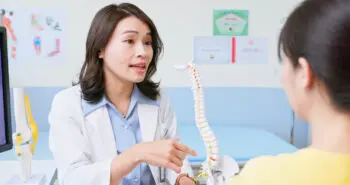Due to the explosion of telemedicine during the COVID-19 era, patients are no longer restricted to their local town or doctor. Thanks to the internet, geographical boundaries have evaporated. This has pushed providers to be at the forefront of their specialty, as patients are coming to their telemedicine appointments with better prepared questions.
Patients are expecting more of their physicians, and they want research-based answers regarding their care. The era of telemedicine brings a new healthcare consumer, one who looks for informational resources to locate the best care and make better informed decisions about that care. By using the computer for health care, patients are one click away from being able to access educational information that can help them have the best outcomes from their treatment.
>>>> Hollywood v. Reality: Q&A About the Spine You See on TV
The National Spine Health Foundation (NSHF) utilizes Spine-Talks® to help fulfill the need to educate patients. Spine-talks brings unparalleled access to world class experts who discuss key topics in spinal healthcare. By tuning in to this free resource, patients can hear directly from some of the nation’s most recognized spinal health experts to get information firsthand regarding their options, including non-operative options. Sometimes, patients may need surgery to correct the problem, and Spine-Talks can help patients better understand when surgery may be the right choice. This can help them ask their doctor better questions at their visit, either in person or through telemedicine.
A recent example in my practice involved a patient from Michigan seeking care for a complicated spine problem. Her local doctors were not giving satisfactory answers to her questions, advising that her issue was too complex for surgery. She had been bedridden for more than three years due to the severity of her pain and she did not want to continue living that way. She had a prior scoliosis surgery when she was a teenager, but now she had structurally broken down below her fusion. She sought three different surgeons around the country using telemedicine. When she contacted me, I shared the educational resources from NSHF with her, and together, we made an informed decision about her course of treatment. We were able to solve her issue and get her back to her life.
>>>>> Returning to the Gym: Reducing Back Injuries While Working Out
COVID ushered in the era of telemedicine. And with that, comes the paradigm of using your computer for your healthcare. With increased connectivity, providers need to help educate patients. One way to do so is by pointing them to high quality, trusted information directly from the authorities in spinal care, where they can learn the most recent advances and use data driven options to make informed choices. NSHF provides just this information. Given that most people will suffer from back and neck issues at some point in their lifetime, educating the public about spinal health is of the utmost importance. We are proud to be leading the efforts in patient education and advocacy through Spine-Talks and at spinehealth.org, as well as investigating clinical outcomes to prove which treatments give the best patient outcomes. An educated patient will have the best outcomes.
by Ehsan Jazini, M.D., Spine Health Journal Editor-in-Chief
Read more in the Spine Health Journal here.




